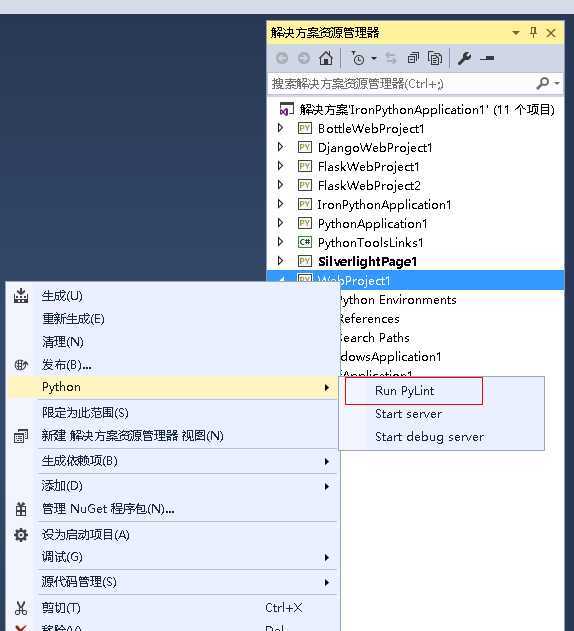标签:des blog http io ar color 使用 sp for
Pylint 是一个 Python 代码分析工具,它分析 Python 代码中的错误,查找不符合代码风格标准(Pylint 默认使用的代码风格是 PEP 8,具体信息,请参阅参考资料)和有潜在问题的代码。目前 Pylint 的最新版本是 pylint-0.18.1。

-h,--help
显示所有帮助信息。
--generate-rcfile
可以使用 pylint --generate-rcfile 来生成一个配置文件示例。可以使用重定向把这个配置文件保存下来用做以后使用。也可以在前面加上其它选项,使这些选项的值被包含在这个产生的配置文件里。如:pylint --persistent=n --generate-rcfile > pylint.conf,查看 pylint.conf,可以看到 persistent=no,而不再是其默认值 yes。
--rcfile=<file>
指定一个配置文件。把使用的配置放在配置文件中,这样不仅规范了自己代码,也可以方便地和别人共享这些规范。
-i <y_or_n>, --include-ids=<y_or_n>
在输出中包含 message 的 id, 然后通过 pylint --help-msg=<msg-id>来查看这个错误的详细信息,这样可以具体地定位错误。
-r <y_or_n>, --reports=<y_or_n>
默认是 y, 表示 Pylint 的输出中除了包含源代码分析部分,也包含报告部分。
--files-output=<y_or_n>
将 每个 module /package 的 message 输出到一个以 pylint_module/package. [txt|html] 命名的文件中,如果有 report 的话,输出到名为 pylint_global.[txt|html] 的文件中。默认是输出到屏幕上不输出到文件里。
-f <format>, --output-format=<format>
设置输出格式。可以选择的格式有 text, parseable, colorized, msvs (visual studio) 和 html, 默认的输出格式是 text。
--disable-msg=<msg ids>
禁止指定 id 的 message. 比如说输出中包含了 W0402 这个 warning 的 message, 如果不希望它在输出中出现,可以使用 --disable-msg= W0402
Pylint的默认输出格式是原始文本(raw text)格式 ,可以通过 -f <format>,--output-format=<format> 来指定别的输出格式如html等等。在Pylint的输出中有如下两个部分:源代码分析部分和报告部分。
源代码分析部分:
对于每一个 Python 模块,Pylint 的结果中首先显示一些"*"字符 , 后面紧跟模块的名字,然后是一系列的 message, message 的格式如下:
MESSAGE_TYPE: LINE_NUM:[OBJECT:] MESSAGE
MESSAGE_TYPE 有如下几种:
(C) 惯例。违反了编码风格标准
(R) 重构。写得非常糟糕的代码。
(W) 警告。某些 Python 特定的问题。
(E) 错误。很可能是代码中的错误。
(F) 致命错误。阻止 Pylint 进一步运行的错误。
************* Module utils C: 88:Message: Missing docstring R: 88:Message: Too few public methods (0/2) C:183:MessagesHandlerMixIn._cat_ids: Missing docstring R:183:MessagesHandlerMixIn._cat_ids: Method could be a function R:282:MessagesHandlerMixIn.list_messages: Too many branches (14/12)
报告部分:
在源代码分析结束后面,会有一系列的报告,每个报告关注于项目的某些方面,如每种类别的 message 的数目,模块的依赖关系等等。具体来说,报告中会包含如下的方面:
下面是一个从 xml 文件中读取一些值并显示出来的一段 Python 代码 dw.py,代码如下:
import string
#!/usr/bin/env python
import xml.dom.minidom
xmlDom=xml.dom.minidom.parse("identity.xml")
organizations = xmlDom.getElementsByTagName(‘DW‘)
for org in organizations:
products = org.getElementsByTagName(‘linux‘)
for product in products:
print ‘ID: ‘ + product.getAttribute(‘id‘)
print ‘Name: ‘ + product.getAttribute(‘name‘)
print ‘Word Count: ‘ + product.getAttribute(‘count‘)
<IBM>
<DW>
<linux id="100" name="python" count="3000" />
</DW>
</IBM>
这时候使用 Pylint 的结果(这是从 html 格式的输出中拷贝的)为:
************* Module dw
C:1:Missing docstring
C:5:Operator not preceded by a space xmlDom=xml.dom.minidom.parse("identity.xml") ^
C:5:Invalid name "xmlDom" (should match (([A-Z_][A-Z0-9_]*)|(__.*__))$)
C:6:Invalid name "organizations" (should match (([A-Z_][A-Z0-9_]*)|(__.*__))$)
Report 部分省略
输出中第一部分是源代码分析,第二部分是报告。输出结果中有这么多信息,从哪里开始分析呢?首先使用如下的步骤来分析代码:
1. 因为输出结果太长,所以可以先不让它输出报告部分,先根据源代码分析部分来找出代码中的问题。使用选项 "--reports=n"。
2. 使用选项 "--include-ids=y"。可以获取到源代码分析部分每条信息的 ID。
************* Module dw
C0111: 1: Missing docstring
C0322: 5: Operator not preceded by a space xmlDom=xml.dom.minidom.parse("identity.xml") ^
C0103: 5: Invalid name "xmlDom" (should match (([A-Z_][A-Z0-9_]*)|(__.*__))$)
C0103: 6: Invalid name "organizations" (should match (([A-Z_][A-Z0-9_]*)|(__.*__))$)
每个信息前面都会加上一个 id, 如果不理解这个信息的意思,可以通过 pylint --help-msg=id来查看。
C0111: *Missing docstring* Used when a module, function, class or method has no docstring. Some special methods like __init__ doesn‘t necessary require a docstring. This message belongs to the basic checker.
3. 开始分析每个源代码中的问题。从上面知道,第一个问题的原因是缺少 docstring,在代码中增加 docstring, 修改后的代码如下:
#!/usr/bin/env python
"""This script parse the content of a xml file"""
import xml.dom.minidom
xmlDom=xml.dom.minidom.parse("identity.xml")
organizations = xmlDom.getElementsByTagName(‘DW‘)
for org in organizations:
products = org.getElementsByTagName(‘linux‘)
for product in products:
print ‘ID: ‘ + product.getAttribute(‘id‘)
print ‘Name: ‘ + product.getAttribute(‘name‘)
print ‘Word Count: ‘ + product.getAttribute(‘count‘)
重新运行 pylint --reports=n --include-ids=y dw.py,结果为:
************* Module dw
C0322: 7: Operator not preceded by a space
xmlDom=xml.dom.minidom.parse("identity.xml")
^
C0103: 7: Invalid name "xmlDom" (should match (([A-Z_][A-Z0-9_]*)|(__.*__))$)
C0103: 8: Invalid name "organizations" (should match (([A-Z_][A-Z0-9_]*)|(__.*__))$)
可以看到源代码中的第一个问题已被解决。
4. 关于第二个 C0322 的问题,这里的分析结果说明得比较清楚,是代码第七行中的等号运算符两边没有空格。我们在这里加上空格,重新运行 pylint --reports=n --include-ids=y dw.py,结果为:
************* Module dw C0103: 7: Invalid name "xmlDom" (should match (([A-Z_][A-Z0-9_]*)|(__.*__))$) C0103: 8: Invalid name "organizations" (should match (([A-Z_][A-Z0-9_]*)|(__.*__))$)
5. 可以看到现在问题只剩下 C0103 了。这里的意思是变量命名规则应该符合后面正则表达式的规定。Pylint 定义了一系列针对变量,函数,类等的名字的命名规则。实际中我们不一定要使用这样的命名规则,我们可以定义使用正则表达式定义自己的命名规则,比如使用选 项 --const-rgx=‘[a-z_][a-z0-9_]{2,30}$‘,我们将变量 xmlDom改为 xmldom, 代码如下:
#!/usr/bin/env python
"""This script parse the content of a xml file"""
import xml.dom.minidom
xmldom = xml.dom.minidom.parse("identity.xml")
organizations = xmldom.getElementsByTagName(‘DW‘)
for org in organizations:
products = org.getElementsByTagName(‘linux‘)
for product in products:
print ‘ID: ‘ + product.getAttribute(‘id‘)
print ‘Name: ‘ + product.getAttribute(‘name‘)
print ‘Word Count: ‘ + product.getAttribute(‘count‘)
运行 pylint --reports=n --include-ids=y --const-rgx=‘[a-z_][a-z0-9_]{2,30}$‘ dw.py,结果中就没有任何问题了。
6. 如果希望一个组里的人都使用这些统一的规则,来规范一个部门的代码风格。比如说大家都使用 --const-rgx=‘[a-z_][a-z0-9_]{2,30}$‘作为命名规则,那么一个比较便捷的方法是使用配置文件。
使用 pylint --generate-rcfile > pylint.conf来生成一个示例配置文件,然后编辑其中的 --const-rgx选项。或者也可以直接 pylint --const-rgx=‘[a-z_][a-z0-9_]{2,30}$‘ --generate-rcfile > pylint.conf,这样生成的配置文件中 --const-rgx选项直接就是 ‘[a-z_][a-z0-9_]{2,30}$‘了。
以后运行 Pylint 的时候指定配置文件:pylint --rcfile=pylint.conf dw.py
这样 Pylint 就会按照配置文件 pylint.conf中的选项来指定参数。在一个部门中,大家可以共同使用同一个配置文件,这样就可以保持一致的代码风格。
7. 如果把 report 部分加上,即不使用 --reports=n,可以看到报告部分的内容。
标签:des blog http io ar color 使用 sp for
原文地址:http://www.cnblogs.com/Running_Zhang/p/4122100.html